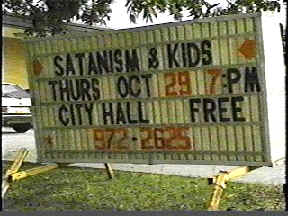the Spirit Watch
The
Truth About Satanism

By Lance E. King, Spiritwatch Ministries
A
NOTE OF CAUTION: Please note that the following article contains a number of
links to non-Christian source material. In
the interest of accuracy in research, these links have been provided to aid the
mature Christian in gaining an accurate understanding of the beliefs under
discussion. It should go without
saying that a link, for example, to the Church of Satan homepage is not
an endorsement of their beliefs. Be
aware that we do not maintain editorial control over such links, and material
contained on these sites may be offensive to some readers.
But there is a problem with this article.
It’s a hoax. The Onion is a satirical publication, boasting countless
articles on totally fictional events. Currently
featured stories have titles like “God Wondering What Happened to That Planet
Where He Made All Those Monkeys” and “Historical Inaccuracy Found in Wild
West Strip Show.” Although the
banner heading describes The Onion as “America’s Finest News Source”, the
not-so-subtle humor is a clear parody of authentic news media.
Sadly, the twisted humor of this article was
missed by at least one sincere Christian, who mistook this gag for genuine news
and thus gave rise to a new urban legend. It’s
not hard to imagine how someone searching for information on Harry Potter
happened upon this article while searching “Yahoo”. Of course, this isn’t the first time sincere Christians
have been duped by a whopper that plausibly validated our worldview.
Since 1980, rumors of alleged financial ties
to the Church of Satan have plagued Proctor & Gamble.
As the story goes, a representative of P&G appeared on Phil Donahue
(or Sally Jesse Raphael, in newer versions of the story) and claimed to give a
percentage of the company’s earnings to that organization.
Many well-meaning Christians have forwarded this information, urging
other Christians to boycott P&G’s products.
The tragedy of the boycott is that it’s based on an utter lie.
This groundless rumor continues to be circulated 20 years later,
evidently because some religious folks can’t resist spreading such sensational
stories. (For more information on
this and other urban legends, check out the Urban
Legends Reference Pages.)
In today’s digital world, this credulity
is exacerbated by the lightning speed at which misinformation can be
perpetuated. A clever, cynical hoax
sent to one person via email before breakfast can reach thousands—even
millions—by dinnertime. Examples
of these kinds of urban legends abound, and the problem is getting worse as we
uncritically read and forward whatever arrives in the “Inbox”.
The time for Christians to employ critical thinking skills is now.
When it comes to a sensational topic like
Satanism, our minds naturally conjure up occult imagery from popular movies,
bizarre “X-Files” episodes and satanic crimes retold by Satanism
“experts”. Depending on how
many books and seminars one has absorbed, grotesque imagery of animal
sacrifices, women compelled to be “breeders” for human sacrifice, ritual
satanic abuse and other unspeakable acts come to mind.
These stories are often said to signify a vast, global conspiracy that
purportedly includes Freemasons, witches, Jesuit priests, corrupt law
enforcement officials and liberal Protestant ministers (especially those who
preach from any of those “New Age” Bible versions).
Just How Widespread Is It?
Some prominent Christian leaders have claimed that thousands—even millions—of people today are involved in a satanic conspiracy of unimaginable influence. Since the 1970s, a number of Christians claiming involvement in satanic movements have stepped forward to tell their stories. Self-proclaimed former high satanic priest, Mike Warnke, told one such story. Spanning a ministry career of about 20 years, Warnke enthralled audiences with details of his occult past and dramatic conversion to Christ. Thousands attended Warnke’s concerts to enjoy his trademark comedy and hear his dramatic testimony. Warnke’s popularity came to an abrupt end when Christian investigative journalists painstakingly uncovered the many deceptions on which he had based his entire ministry.
Other would-be celebrities have similarly
tapped the religious market for the sensational, each writer rising to new
heights of horror fiction. Ruth
Bailey, aka “Rebecca
Brown” wrote several books (published by conspiracy conglomerate, Chick
Publications) in which she claimed to have direct encounters with demonic
powers—including a werewolf—and firsthand exposure to a satanic conspiracy
that reached as far as the Vatican. Lauren
Stratford, author of Satan’s Underground, relayed horrifying tales
of satanic ritual abuse she allegedly experienced as a child.
Both women were eventually exposed as frauds by Christians who cared
about the truth more than making a fast buck in the religious retail market.
The majority of these fraudulent stories
portray a satanic movement that is overwhelmingly vast and powerful, even
virtually inescapable. The
pervasive message seems calculated to produce hopelessness, and the Christian
believer is always reminded of the satanic influences that must be diligently
warded off by various ritualistic means if we are to survive. Fear, suspicion and an unhealthy obsession with Satan’s
power are the hallmark of such “ministries”.
But Aren’t They Everywhere?
According to data gathered from various
sources on Adherents.com, estimates of
the actual number of professing Satanists depend greatly on whom you ask.
Some researchers estimate there are as many as 15,000-100,000 Satanists
in the United States, while others say there are no more than 3,000 total
worldwide. Because they are
generally an elitist and secretive bunch, it is difficult to say just how many
Satanists there are. One thing is clear: there are nowhere near as many professed
Satanists as there are Mormons, Jehovah’s Witnesses, or any other “garden
variety” cultist. (Mormons,
for example, are currently preaching their “restored” gospel by means of a
PR-savvy missionary force 10 times greater than that of Southern Baptists!)
As Halloween approaches again this year,
many Christians will be exposed to religious broadcasts and literature designed
to warn them against the dangers of satanic activity.
While most of those writing about these issues have the best of
intentions, they are often plagued by sub-standard research, hearsay and
superstition concerning the beliefs of Satanists and other non-Christian
beliefs. The unfortunate result is
that informed people—including many who proudly wear the title of “Pagan”
or “Neopagan”—see this kind of misinformation promoted by Christians and
are generally turned off by the misrepresentations they hear.
After all, if we can’t accurately describe their beliefs, why
should they trust what we have to say about Jesus?
In a tract published by Bible Baptist Church
of Sharon, Tennessee, entitled Should Christians Observe Halloween, James
T. Melton writes:
Witches are worshipers of Satan, and they
are an abomination to God… Why would a God-fearing Christian want to dress
their child like something that God hates?
As we will discuss shortly, “witches”
are not worshipers of Satan. Contemporary
witchcraft is comprised of an eclectic mix of folk beliefs, magical practices,
and goddess worship—hardly practices consistent with Christianity, but most
definitely not “devil worship”. Wicca
(a popular witchcraft religion), in particular vehemently rejects belief in
Satan, preferring generally to worship a number of gods and goddesses (either
literally, or as symbolic manifestations of nature).
While Christians are Biblically obligated to
test the spirits and reject false religious beliefs, we must be careful to
distinguish fact from urban legends. Although
antithetical to Christian doctrine, Islam, Buddhism and Hinduism are all
examples of world religions that likewise do not worship Satan.
While we might observe that false beliefs are generally “satanic” to
the extent that they turn people away from the person of Jesus, very few
adherents of any religion are so twisted as to consciously worship what they
believe is evil.
Jehovah’s Witnesses are a good example of
a pseudo-Christian cult that actively opposes devil worship and all
occult practices while still holding out another
“Jesus” for their proselytes. More
pointedly, both belief systems will lead the seeker away from God with the same
eternal results. Or do we actually
believe a Mormon is better off with Joseph Smith’s “restored gospel”
(which teaches that men may become gods) than the Satanist with his copy of
“The Satanic Bible” (which teaches that man is an animal)?
 Melton goes on to urge parents against
letting their children celebrate this Pagan festival, stating:
Melton goes on to urge parents against
letting their children celebrate this Pagan festival, stating:
Friend,
Halloween is Satanic! You may
pretend that it’s a harmless game for kids, but in reality it represents
Paganism, Satanism, human sacrifice, torture, rape, murder, idolatry,
witchcraft, and spiritualism! Did
you know that October 31st is considered by Satanists to be their
most important day of the year?
Our friend makes a number of startling
claims about what Halloween “represents”.
He seems to imply that this is a matter of common knowledge, and offers
us no documentation for these claims. Is
Mr. Melton suggesting that all of these activities actually occur on Halloween?
If so, he should provide some documented examples so that the reader can
be warned, and law enforcement properly briefed where criminal acts are
involved. Or does he simply mean to
assert that Halloween historically involved these activities and so
should be avoided today in light of its tainted past?
Of course, no one denies that Halloween is
an important day to contemporary Pagans and Satanists alike.
The pre-Christian festival, Samhain,
is celebrated by hundreds of thousands of Neopagans each Halloween, and the
numbers grow each year as Neopaganism steadily gains mainstream acceptance in
the Western world. With respect to
the importance of Halloween to Satanists, however, Mr. Melton is incorrect.
Halloween is not the high “unholy” day of modern Satanists.
In reality, a Satanist’s birthday
is his or her most important day of the year for reasons that will become
apparent later in this article.
So What Is Satanism?
As we approach this controversial issue, it may be helpful to review what the Bible has to say on the subject:
(This space intentionally left blank.)
Curiously, the Bible is silent on the subject of the subject of Satanism as a religion. That is not to say that the Bible does not tell us certain things about Satan; in fact, it has much to say about the devil. Nor are we saying that the Bible lacks information concerning Satan’s activities. We are sternly warned to guard against his lies:
1 Peter 5:8-9 - Be self-controlled and
alert. Your enemy the devil prowls around like a roaring lion looking for
someone to devour. Resist him, standing firm in the faith, because you know that
your brothers throughout the world are undergoing the same kind of sufferings.
We want to be clear in establishing 2 facts from Scripture:
-
There is such a being known as Satan, or the devil, described in the Bible
-
Satan seeks to deceive and devour those whom he can lead away from the truth of the Gospel of Jesus Christ.
There are a number of ways in which Satan can deceive people. While it is not the topic of this article, many of his tactics have nothing to do with the introduction of false teaching, much less any overt attempt to get us to worship him. (C.S. Lewis does an excellent job describing some of the more mundane ways Satan keeps our eyes off from Christ, in his book The Screwtape Letters.) While few people are inclined to commit their lives to ritualized satanic worship, we are all vulnerable to the more subtle deceptions Satan offers us.
The
main reason the Bible doesn’t mention Satanism as a religious institution is
due to the fact that until the Enlightenment era, there really was nothing
resembling it. One of the first
philosophies that set the stage for contemporary Satanism was actually invented
by a disenchanted Catholic priest named François
Rabelais. In a 1535 novel, Rabelais
created a literary paradise governed by what he called the Law of Thélème. The
fundamental Law of Thélème
was “do what thou wilt”—a phrase later commandeered by Satanists and
Wiccans alike (although not without significant moral
tempering by the more socially conscious Wiccans).
The European “hellfire” or “anti-morality” clubs built upon Rabelais’ vision of self-indulgence in the 17th and 18th centuries. These groups celebrated the excesses of their carnal appetites, and mocked the sensibilities of the Church through elaborate “Black Masses”. It’s important to note that the ceremonies were not an expression of sincere belief, but were an open mockery of institutionalized religion. Anti-moralists were not espousing a belief in anything, except their own pleasure.

- Rejection of Christianity
- Assumption of the supremacy of the self
- The use of magic to enhance one’s experiences and reach one’s goals
Picking up where Crowley left off, Anton
Szandor LaVey (1930-1997) founded the Church
of Satan (CoS) in 1966. LaVey
was a former carnival worker, whose personal interactions with Christians led
him to conclude that Christianity was hypocritical and morally restrictive.
He summarized his philosophy in The Satanic Bible (1969) in what
he described as The Nine Satanic Statements:
-
Satan represents indulgence instead of abstinence!
-
Satan represents vital existence instead of spiritual pipe dreams!
-
Satan represents undefiled wisdom instead of hypocritical self-deceit!
-
Satan represents kindness to those who deserve it instead of love wasted on ingrates!
-
Satan represents vengeance instead of turning the other cheek!
-
Satan represents responsibility to the responsible instead of concern for psychic vampires!
-
Satan represents man as just another animal, sometimes better, more often worse than those that walk on all-fours, who, because of his “divine spiritual and intellectual development,” has become the most vicious animal of all!
-
Satan represents all of the so-called sins, as they all lead to physical, mental, or emotional gratification!
-
Satan has been the best friend the Church has ever had, as He has kept it in business all these years!
 It may surprise many readers to learn that the founder of
the Church of Satan was fundamentally an atheist.
While he did use occult imagery and celebrated his own version of the
“Black Mass,” the focus of these activities was to free the adherent from
the constraints of “right-hand path” or “white light” religion, which he
saw as oppressive. As we see in the above statements, “Satan” to LaVey was a
personification of his humanistic values, not a literal being to be worshipped
or feared.
It may surprise many readers to learn that the founder of
the Church of Satan was fundamentally an atheist.
While he did use occult imagery and celebrated his own version of the
“Black Mass,” the focus of these activities was to free the adherent from
the constraints of “right-hand path” or “white light” religion, which he
saw as oppressive. As we see in the above statements, “Satan” to LaVey was a
personification of his humanistic values, not a literal being to be worshipped
or feared.
While the Church of Satan is undoubtedly the
best-known satanic organization, there are other organizations, such as the Temple
of Set, which have a more mystical orientation.
Setians are a particularly elitist group, and draw heavily from
Egyptian mythology in formulating their satanic philosophy.
They see themselves as a truly spiritual and philosophical path, and
express a general disdain for those who fail—for lack of intelligence or
intuition—to meet their elite standards:
If you do not possess high intelligence, the exercises of
initiation will simply be beyond your capacity, and you must have the common
sense and honesty to recognize that and seek personal happiness elsewhere.
Setians further distinguish themselves as enjoying superiority over other belief systems, expressing their elite values in certain terms:
The Temple of Set evaluates conventional
religions as erroneous in principle and therefore unworthy of peer status. We
feel no need to concern ourselves with their activities, nor for that matter to
maintain any sort of "diplomatic relations" with them [as in councils
of churches]. Our position is that they may serve a useful social function as
purveyors of soothing myths and fantasies to humans unable to attain Setian
levels of self-consciousness. Hence we ignore conventional religious
organizations unless they intrude upon our affairs.
Satanists belonging to either of these
organizations take extreme pride in their intelligence, creativity and wit.
They are disdainful of “pretenders” and often point out the
superficiality of those (especially adolescents) who embrace the symbols of
Satanism without taking the time to research its philosophical underpinnings.
They often use biting humor to make a point, and generally revel in their
perceived freedom from the “herd” mentality of larger society. The main differences between these groups seem to lie in
their views on the supernatural. For
members of the CoS, magick is a showy ritual that frees the open-minded person
from the tyranny of belief (whatever that belief might have been); for the
Setian, magick is a real tool that makes a strong person even stronger.
 Since
Satanists are part of a highly diversified and individualistic movement, it
naturally follows that there are innumerable lesser-known groups and solitary,
eclectic practitioners with numerous, contradictory ideologies.
Anyone can gain attention by claiming to be a Satanist.
And Satanism exerts a powerful influence over insecure adolescents who
often identify with the commercialized “Satanism” found in popular music
(like Marilyn Manson) and occult movies. While
we should be careful not to minimize these negative influences on our young
people, it should be observed that these flavors of “Satanism” are usually
passing fads birthed from young people’s sense of powerlessness in a rapidly
changing world. While some
self-described Satanists (primarily youths) do occasionally commit so-called
“satanic crimes”, such isolated events are hardly indicative of a massive
conspiracy.
Since
Satanists are part of a highly diversified and individualistic movement, it
naturally follows that there are innumerable lesser-known groups and solitary,
eclectic practitioners with numerous, contradictory ideologies.
Anyone can gain attention by claiming to be a Satanist.
And Satanism exerts a powerful influence over insecure adolescents who
often identify with the commercialized “Satanism” found in popular music
(like Marilyn Manson) and occult movies. While
we should be careful not to minimize these negative influences on our young
people, it should be observed that these flavors of “Satanism” are usually
passing fads birthed from young people’s sense of powerlessness in a rapidly
changing world. While some
self-described Satanists (primarily youths) do occasionally commit so-called
“satanic crimes”, such isolated events are hardly indicative of a massive
conspiracy.
Much has been made in recent years of what is sometimes termed “Satanic Ritual Abuse.” While space precludes a thorough treatment of the topic in this article, we refer the reader to an excellent article by the Passantino’s, entitled The Hard Facts About Satanic Ritual Abuse, in which they demonstrate the unsubstantiated nature of such claims. The article is heavily documented and very informative, and a must-read for anyone concerned about this topic.
In 1992, after an exhaustive and thorough
investigation into the "Satanic panic" that swept America in the
1980's, FBI investigator Kenneth Lanning produced a landmark
document that summarized his own quest for the truth about Satanic ritual
abuse. He finally concluded that "for at least eight years (Note 1) American law enforcement has been aggressively
investigating the allegations of victims of ritual abuse. There is little or no evidence for the portion of their allegations that deals with large-scale baby
breeding, human sacrifice, and organized satanic conspiracies." In light of
the scarcity of any relevant corroborative evidence, we find ourselves compelled
to conclude that - at the very least - there is no proof whatsoever of the kind
of Satanic conspiracies that are said to be behind Satanism today.
Instead, evidence does point out that there are isolated and sick
individuals (mostly alienated young teens and men) who have committed terrible
crimes in the name of their god, "Satan" (or that is to say,
their own feral anger and hostility channelled into a religious bent).
A Christian Response To Satanism
While evangelicals have written countless
manuals on how to present the Gospel to non-believers, there’s not a lot of
credible material to aid the Christian in responding to Satanism specifically.
When approaching Satanism, it is helpful to keep some key principles in
mind:
- Satanism, while sensational, is not particularly widespread. You are far more likely to meet a member of a pseudo-Christian cult or major world religion (such as Hinduism) than you are to meet a Satanist. It is wise to spend time acquainting yourself most with the beliefs of those you are likely to meet in your geographical area, rather than obsessing needlessly about a handful of elitists. Christian researcher Craig Hawkins offers some fine insight into the many faceted shades of belief held by contemporary Satanists: to access his online article, click here.
- Satanists are not waiting for someone to come share Christ. By virtue of his or her beliefs, Satanists are generally hostile toward organized religion, the Bible and Jesus Christ. Your approach to sharing your faith should begin with serious reflection on how your life reflects Christ in you. Beyond that principle, you can generally approach the Satanist as a practical agnostic or atheist. As has been said so well in the past, Satanism is actually secular humanism wearing a devil's mask.
- If you meet someone whom you believe is a Satanist, make sure that you understand his or her beliefs before making assumptions. Since Satanists are fiercely individualistic, it is unwise to jump to conclusions regarding that person’s view of heaven, hell, God, Satan, magic, etc
- Take the time to understand the important differences between Paganism, Wicca and Satanism. Many Wiccans, in particular, have been frustrated by Christians who insist they are devil worshippers. Two good primary sources to help you learn about and compare these different belief systems are:
- FAQs for Paganism and Wicca: http://homepage.mac.com/Paganrain/index.html
- FAQ for Satanism: http://www.luckymojo.com/faqs/faq.astnngp.9907
 Satanism poses a special challenge to
Christians, but not for the reasons popularly portrayed by Hollywood. Sadly, much misinformation has been repeated by Christian
leaders who ought to know better, but who have failed to take the time to really
understand what Satanism is about. Some
have shamelessly used the hot button of Satanism to promote their own
egotistical agendas, sell books and impress people with the “inside”
knowledge they have gained through their amazingly unique battles with the
Prince of Darkness. These are
God’s special “warriors” and they need your money to get the job done.
Don’t buy it.
Satanism poses a special challenge to
Christians, but not for the reasons popularly portrayed by Hollywood. Sadly, much misinformation has been repeated by Christian
leaders who ought to know better, but who have failed to take the time to really
understand what Satanism is about. Some
have shamelessly used the hot button of Satanism to promote their own
egotistical agendas, sell books and impress people with the “inside”
knowledge they have gained through their amazingly unique battles with the
Prince of Darkness. These are
God’s special “warriors” and they need your money to get the job done.
Don’t buy it.
Countless books have been written on the
subject of spiritual warfare, inspiring covers with medieval-looking swords
wielded by muscle-bound Christian warriors symbolically vanquishing demonic
forces. We must be careful to
acknowledge that spiritual warfare is a very real thing, and moreover is the
privilege of every believer in Christ:
Ephesians 6:11 - Put on the full armor of
God so that you can take your stand against the devil's schemes.
However, it is important that we not isolate
Satanism as a special category of spiritual warfare.
Notice that in the Scripture above, the “weapons” described in the
following verses are not “magical” incantations, but the practical
outworking of the Christian life. Contrary
to what some Christians have been taught, we do not put on the full armor of God
through reciting some “magic” prayer. We
put on the armor of God by living as people who are in Christ.
Naturally, prayer is an important component of that armor, but there is a
holistic picture of the Christian life presented here that’s not always as
dramatic as those pretty paintings Christian bookstores sell for $150 apiece.
Satan really doesn’t care if you reject
Christ for any of the following reasons:
- You think Christians are all hypocrites and therefore, not worthy of your time.
- You prefer to keep your spiritual “options” open and choose to drift from Neopaganism, to shamanism, to Buddhism, to inspirational moments with motivational speaker Tony Robbins.
- You are an avowed atheist, and Charles Darwin was your great, great, great grandfather. Carl Sagan is your patron saint.
- Your “religion’s” sacred vestments are orange and white, and stamped with a big “UT” on the front and back…
- You are a regular church attendee, and think Jesus was an all-right sort of guy for those bad sinners, even though you aren’t yet convinced you are one.
- You’re into the Goth scene, and really dig freaking people out with your black fingernails and “expressive”, crimson velvet clothes.
- You worship Marilyn Manson and want to be a satanic god. You might have stolen your very own copy of The Satanic Bible from Barnes & Noble, and have even read portions of it before parading it around at high school.
- You’re a highly cultured, Ipsissimus/ Ipsissima VI Setian initiate who wouldn’t be caught dead with the likes of #7.
 The point is this: Without the transforming
power of Jesus Christ, all of us are equally lost.
A “good” Christian boy who learned early on how to impersonate
a Christian walk, but never surrenders his heart to Jesus is no closer to
Eternal Life than his college roommate who grew up without a Bible in sight.
As hard as we try to find it, there is nothing in Scripture that would
suggest to us that some sinners are better off than others.
We do well to remember that “all have sinned and fall short of the
glory of God” (Rom 3:23).
The point is this: Without the transforming
power of Jesus Christ, all of us are equally lost.
A “good” Christian boy who learned early on how to impersonate
a Christian walk, but never surrenders his heart to Jesus is no closer to
Eternal Life than his college roommate who grew up without a Bible in sight.
As hard as we try to find it, there is nothing in Scripture that would
suggest to us that some sinners are better off than others.
We do well to remember that “all have sinned and fall short of the
glory of God” (Rom 3:23).
There are lots of Christians who will buy
books on how to identify occult themes in the latest popular toys. And we really like to hear the juicy details from someone who
claims “inside knowledge” about mysterious and evil things, don’t we?
The time has come, however, for us to come to grips with the deeper,
seemingly mundane aspects of the Christian walk: prayer, discipline, studying
God’s Word. The problem for most
of us is that these things take work, and thought, and careful study.
And the kinds of issues that have a lasting impact often aren’t
reflected in the book titles that sell so well.
In closing, it might be wise for us to
carefully consider the advice offered by Church of Satan Magister Peter
H. Gilmore to young Satanists seeking to make a positive impression. The parallels for Christian living are self-evident:
“The person who has a talent for baking and figures out how to make some damn fine chocolate chip cookies, and then shares this secret with friends (enriching their world with delicious cookies), or makes an empire out of selling these to other people, is someone who is using a Satanic principle to further their lives. If this person becomes a world famous cookie magnate, or just the neighborhood’s most revered baker, and THEN lets people know that his philosophy is Satanism, then THAT is a deed which forwards the movement. Our baker will have demonstrated that a Satanist is a person with the capability to do something exemplary. Dressing up weirdly, making shabby websites, and screaming to the world that you are a “Satanist” only impresses utter fools, and does nothing to help our movement.”
Comments, questions or hate mail may be addressed to the author at leking@knology.net.
Back To The SpiritWatch Home Page Back To The Occult Renaissance